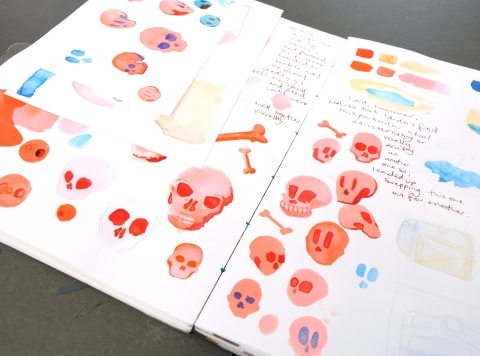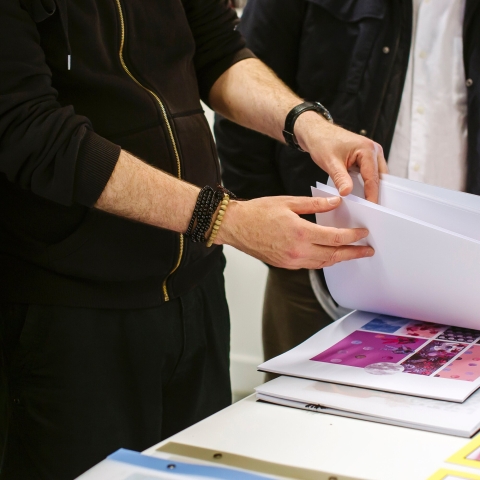
Across a range of creative, design and technical courses at the University of Portsmouth, a portfolio is likely to have been an essential part of your course.
In this guide:
- What is a portfolio?
- Types of portfolio
- Options for presenting your portfolio
- Subject-specific guidance
- Top tips
- Portfolio Checklist
What is a portfolio?
A portfolio is your sales brochure. It not only promotes your work, but you as a potential employee or student. It enables you to show examples of your work that are difficult to communicate through a CV alone, and is a chance to reflect your personality, creative process, and unique areas of interest.
Portfolios are commonly used for:
- job roles (including internships, placements and graduate roles)
- further study in the creative and technical sectors
- freelance and client-based work

Types of portfolio
The type of portfolio you use depends on where you are in the recruitment process. You may require a more concise portfolio for initial applications and/or enquiries, then a more detailed portfolio when meeting employers/clients.
Applications and initial enquiries
Application portfolios are used when submitting your portfolio as part of an application or initial enquiry with a client. This should:
- be short, impactful, and tailored to each role
- show relevant examples that demonstrate adaptability and range
- include only a few pieces that speak directly to the employer or client
Interviews and meetings
When taking your portfolio to an interview or a client you should use a full design portfolio. This should:
- Include a range of work
- emphasise your latest and strongest projects first
- focus on quality over quantity
Further study applications
You may require an application portfolio and/or a full design portfolio when applying to further study courses. You should:
- follow the specific portfolio requirements for each course
- highlight work you can speak confidently about
- tailor to showcase skills relevant to the course
Options for presenting your portfolio
Whichever format you choose for your portfolio, make sure your cover letter, CV and portfolio all tie up into one consistent brand. You can learn more about this in our Creative CV Guide.
Online portfolios
An online portfolio is an easy way to showcase your work to employers. There are many online design resources or website platforms available to design and host your portfolio, such as:
- Portfoliobox
- Adobe Portfolio (free with Creative Cloud)
- ArtStation - especially for Computer Games Art students
- Format
- Behance
- Coroflot
- Carbonmade
Some people choose to host their work on more than one platform to maximise their outreach. You should research all platforms and reflect on which conveys the correct professional tone to match your brand, and which you feel most comfortable using. Some online portfolio options will have a cost, so consider which options are financially feasible for you.

Social media and portfolios
Platforms like Instagram, LinkedIn, and even Facebook can be powerful tools.
- Use hashtags to increase reach
- Network with professionals
- Maintain a professional tone
Please make sure that your Instagram portfolio is different from your personal portfolio. Also, remember that not all employers will have an Instagram account so they might not be able to view your work
Physical portfolios
A physical portfolio may also be required when attending a job interview or meeting with a potential client. For a physical portfolio, presenting your work neatly in a high-quality, well-bound portfolio can give a favourable impression of your attention to detail and professionalism.
You can also include non-2D materials. You may want to consider whether transporting and including these pieces could compromise their integrity.
Creating visual impact
Design and layout
The design and layout you choose will be an indication of your creative skills. Ensure your portfolio has a consistent layout and a design background that does not detract from the content itself.
High-quality elements
Ensure that the quality of any photography, images, audio samples or textile swatches included is high, as this will impact the viewers' engagement with your content. Aim for clear, professional photos and/or high-quality renders.
Compression and size
Accessibility to your portfolio is key, so make sure digital file sizes are compressed to reduce any access issues when the employer is receiving your content via email. Follow any employer guidelines if these are made available to you.
Organisation of content
Create a narrative with your content, ensuring impact is created at the start of your portfolio and a lasting impression towards the end. To help explain your vision as you progress through your portfolio, include tags and labels to help guide the reader through.
Use your best work
Direct the employer to your best and strongest work with minimal clicks. Although you want to ensure only your very best work is highlighted, consider using incomplete.
Subject-specific guidance
In the below grid you will find subject specific considerations for your portfolio:
- Recruiters often state a maximum file size of 5MB
- Include work from initial concept sketches, site plans and axonometric views to cross sections, final visualisations and construction details.
- Include photos of hand drawings and physical models to evidence software skills and show a range of ability. This will bring an interesting variety to the portfolio.
- Tailor work to the type of practice
Further resources:
- Architecture portfolio for interview (First in Architecture)
- 5 Tips for Improving Your Architecture Portfolio (Architizer)
- When including photographs of your work, use multiple angles and close-ups to show full details
- Include the development stages of your work and how you responded to any challenges or feedback
Further resources:
- Concept Art Portfolio - What makes a portfolio professional and impactful (Atomhawk)
- Consider self-publishing games through Steam or app stores. Understand platforms’ terms and permissions
- Include personal projects as well as coursework.
Further resources:
- Portfolio and reels suggestions (Riot Games)
- Epic Games - Early Careers Career advice (Epic Games)
- Tips and Tricks for building a QA Portfolio (Game Industry.biz)
- How to build a Games Design Portfolio (Game Designing)
- How to make a Level Design Portfolio that will get you hired (Game Design Skills)
- Have both a physical and online portfolio, and adapt the contents to suit each role that interests you
- Include a variety of work samples, such as sketches, technical drawings, mood boards, fabric swatches, and final garment designs
- Demonstrate your ability to conceptualise and execute full collections or lines, not just individual pieces
- Highlight your understanding of fashion trends, textile materials, and construction techniques
Further resources:
- The Perfect Online Fashion Portfolio (Arts Thread)
- Include a professional case study, or client recommendations.
- Describe your creative process and influences
- As well as commercially relevant work, try to show some non-client work, or side projects as well in your portfolio.
Further resources:
- Instantly improve your graphic design portfolio with these expert tips (Creative Boom)
- 7 portfolio tips for Designers (Free Agent)
- Show a consistent style with varied subjects
- Highlight composition, equipment use, and creativity
- Include specific skills or requirements provided to you within a job description or brief from a client.
Further resources:
The information and advice included below is largely focused on those students or graduates from the Faculty of Technology. This will include individuals looking to secure opportunities relating to product design and development, manufacturing, design engineering and/or some computer-based roles, especially web design/development.
- Showcase software skills using work created via 2D or 3D CAD
- Include drawing skills through observational and concept design sketches, highlighting perspective, form, surface and detail
- Show how you research and illustrate the journey, including things like mood boards, colour palettes, sketches and renderings.
- Include written elements such as project titles and concise descriptions of your work – writing is an essential tool for designers to develop critical and communication skills
- Aim to make your reel 1–2 minutes in length
- Put your best work first and show your personality to create a memorable impression on the employers
- Add a title card with your name and contact information
- If you’re including collaborative work in the showreel, make sure you clearly show what your contribution was, and credit the work of others
Further resources:
- BBC Studios - The Perfect Showreel - 5 Top Tips
- How to create your acting showreel (Backstage)
- How to make a set design portfolio (Get into Theatre)
- How to make a lighting design portfolio (Get into Theatre)
- Online portfolios can provide interactivity for viewers and reflect your technical skills
- You could use a portfolio template or create your own to exercise greater control over the format and demonstrate your capabilities.
- Another consideration for you will be whether you use a free hosting site or purchase a domain name, which can enable you to personalise the name to match your professional identity.
Top tips
1. Create a consistent brand
- Use the same fonts, colours and visual style across your CV, cover letter and portfolio
- Keep your tone and layout aligned to show you understand design systems
- Make it feel like one joined-up story about your creative identity
2. Share your work online
- Set up a website or use an online portfolio platform
- Include the URL in your CV as part of your contact details
- Organise your content clearly and make sure it supports your placement goals
3. Choose work that shows your strengths
- Aim for around 10 pieces of work
- 7 that show your core design specialism
- 3 that highlight broader skills or interests
- Include personal projects as well as coursework—show what excites you
- Add collaborative work if relevant, and explain your role clearly
4. Keep it updated
As you create more pieces of work throughout your studies and ultimately your career, it will be important to revisit your portfolio and consider which images best exemplify your work, and whether your personal style has developed and evolved, requiring your portfolio to be updated accordingly.
5. Get feedback
It's always a good idea to receive feedback on your portfolio before you use to apply for job roles and/or further study courses. You have the opportunity to book in for a 40-minute appointment with one of our Careers Advisers - you can request an appointment here.
We would also encourage you to access portfolio support via your personal tutor and/or course tutors, who will have more specific industry knowledge and experience.

Further resources
- Prospects - a guide on putting together a creative portfolio
- Instagram - A good source to connect with a large community of designers
- Code Academy - Guidance on creating a technical portfolio with a focus on coding
- Hatchpad - Targeted portfolio guidance for software engineers
- 99u by Adobe – A beginners guide to appealing to clients with your portfolio
- Guide to making a successful showreel
- ScreenSkills - how to build your portfolio
- Preparing your first Architecture portfolio

Explore more career support
Art and illustration career guide
Your guide to building a career in art and illustration.

Graphic design career guide
All you need to kickstart your career in the graphic design industry.

Computer games technology career guide
Your guide to building a career in computer game technology.







